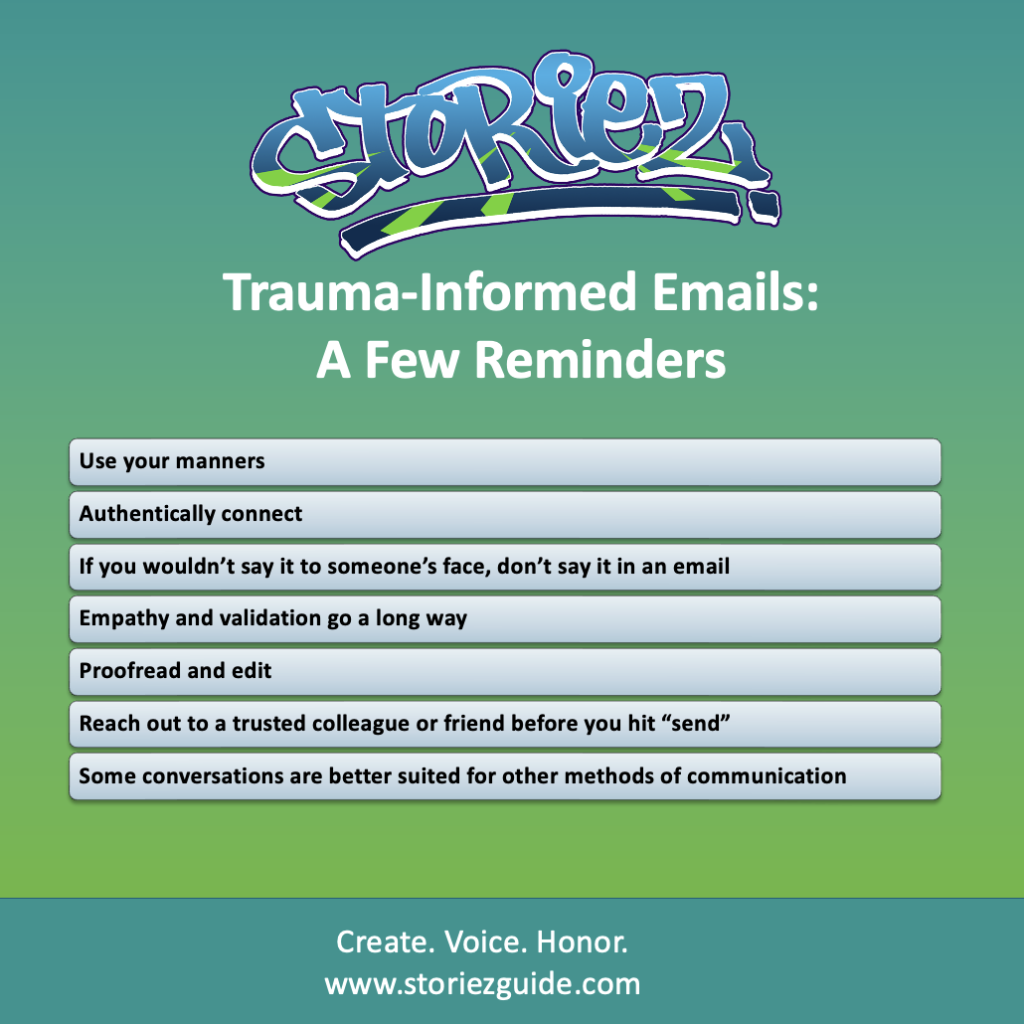
Have you ever received an email that made you cock your head to the side? Roll your eyes? Make you wonder who in the world the person was speaking to? All of us have received them—these emails that rub us the wrong way and send an electric shock through our nervous systems. Some of the senders of these emails have been people who profess to be trauma-informed care advocates. And let’s be honest…many of us when frustrated, overwhelmed, and stressed (myself included!) have also been the culprit.
As clinicians and community partners who are committed to trauma-informed principles, we are aware of the importance of healthy, open communication in creating safe and supportive environments. But for some reason, we fail to apply this knowledge and understanding to our email communication. In an effort to holistically embody trauma-informed principles, let’s take a long, hard look at our email communication. And let’s also identify specific ways to frame our email messages so that they facilitate connection and clarity rather than chaos and frustration.
Use your manners
Would you walk into a conference room without greeting anyone and start making demands? Maybe you would. But most people begin by saying “hello.” Engaging in a little bit of chit-chat about the weather. And then they transition into the nitty gritty of the conversation. Manners are an asset. And the cool thing about them is they’re free!
Authentically connect
We’ve all seen memes making fun of the commonly used email introduction, “I hope this email finds you well.” It’s a generic filler that we add to the beginning of emails to ease our way into the core purpose of our message. Although this introductory sentence isn’t the strongest, it is an attempt to connect with the recipient. When we begin an email by seeking to connect with the recipient, we take the initial steps necessary to foster a positive relationship. And positive relationships are the foundation for deeply meaningful, trauma-informed collaboration.
If you wouldn’t say it to someone’s face, don’t say it in an email
There’s something about a keyboard and a screen that makes people feel emboldened to say things that they would never say to a person’s face. Remember that there is a real person on the other end of the keyboard. A person with feelings. Stressors. Responsibilities. An individual who is not perfect but is doing the best that they can. As you draft your email, ask yourself, “Would I say this to so and so if I were meeting with them face-to-face?” If your answer is no, reconsider your message and brainstorm alternative ways to convey your thoughts and feelings.
Empathy and validation go a long way
When we empathize with others, we step into their shoes and imagine what their life experiences may be like. When we validate others, we make space for their emotions and experiences (even if we don’t agree with them). Empathy and validation are powerful tools in email communication. Sprinkle them generously throughout your paragraphs and sentences like seasoning on fried chicken. They help us acknowledge others’ humanity and also support us in building authentic, meaningful connections. But when we don’t use empathy and validation, we can cause others to feel devalued and dismissed.
Proofread and edit
When communicating about sensitive or conflictual topics, don’t send the first draft. Take it from someone who spent years of their career sending first drafts! It isn’t the wisest move. Give yourself an opportunity to read your email out loud. Move sentences around. Add in niceties. Remove passive aggressive remarks. “Per the previous email” and statements in all caps are never a good look. Re-read the email from the perspective of the recipient. How might they interpret what you said? How might they feel based on how you said what you said? Read it out loud. Sleep on it. Take some time to craft the difficult message. The time you spend proofreading and editing will save you time and energy later. Sending a first draft may cost you exponentially more time and energy doing subsequent damage control. Fixing broken bridges and mending fractured relationships is time consuming!
Reach out to a trusted colleague or friend before you hit “send”
We all need that person that we can vent to. The person who validates our colorful language and listens to our long rants. Reach out to that person before you send your email. That trusted person may be a colleague, supervisor, or friend. Provide them with context about the situation. Tell them your side of the story. Get all of the unedited, uncut feelings out of your system. And once you’ve verbally vomited out all of the toxins, ask them if you can read them your email draft. Ask if they’ll help you remove any words, phrases, or sentences that could be potentially shaming or damaging. Accept their feedback about ways to improve the attitude and tone of your email so that the recipient can better hear, process, and respond to your message.
Some conversations are better suited for other methods of communication
Email is not the be-all, end-all of communication. It is one option, but it isn’t the only option. There are advantages to email communication, but there are also limitations. If you find yourself needing to explain complex information or navigate an emotionally volatile situation, email may not be the best communication platform. Consider how phone calls, Zoom meetings, and in-person discussions may also aid in your communication efforts.

